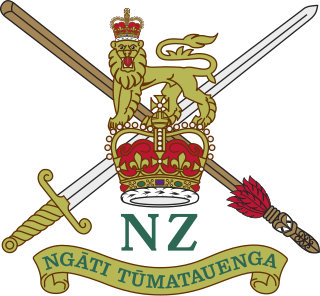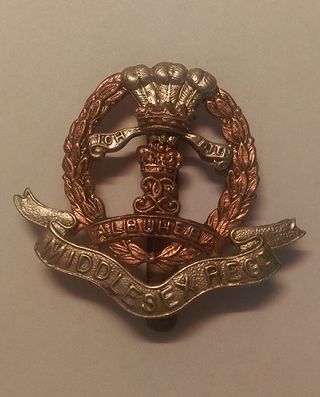
The New Zealand Expeditionary Force (NZEF) was the title of the military forces sent from New Zealand to fight alongside other British Empire and Dominion troops during World War I (1914–1918) and World War II (1939–1945). Ultimately, the NZEF of World War I became known as the First New Zealand Expeditionary Force. The NZEF of World War II was known as the Second New Zealand Expeditionary Force (2NZEF).

The Royal New Zealand Infantry Regiment is the parent administrative regiment and corps of regular and reserve infantry battalions in the New Zealand Army. It was originally formed in 1947 with a singular Regular regiment and multiple reserve regiments. Over time, the regiments were turned into battalions, the reserve units amalgamated and more regular units raised and disbanded. Currently, the Regiment currently consists of two regular and three reserve battalions. Throughout its existence, units raised in this regiment have served and deployed on operations in Malaya, Vietnam, Borneo and various United Nations peacekeeping operations.

The Canterbury, and Nelson-Marlborough and West Coast Regiment was a Territorial Force unit of the New Zealand Army.

A rifleman is an infantry soldier armed with a rifled long gun. Although the rifleman role had its origin with 16th century hand cannoneers and 17th century musketeers, the term originated in the 18th century with the introduction of the rifled musket. By the mid-19th century, entire regiments of riflemen were formed and became the mainstay of all standard infantry, and rifleman became a generic term for any common infantryman.
The British Army is listed according to an order of precedence for the purposes of parading. This is the order in which the various corps of the army parade, from right to left, with the unit at the extreme right being highest. Under ordinary circumstances, the Household Cavalry parades at the extreme right of the line. Militia and Army Reserve units take precedence after Regular units with the exception of The Honourable Artillery Company and The Royal Monmouthshire Royal Engineers.

The Middlesex Regiment (Duke of Cambridge's Own) was a line infantry regiment of the British Army in existence from 1881 until 1966. The regiment was formed, as the Duke of Cambridge's Own (Middlesex Regiment), in 1881 as part of the Childers Reforms when the 57th (West Middlesex) and 77th (East Middlesex) Regiments of Foot were amalgamated with the county's militia and rifle volunteer units.
The Irish military diaspora refers to the many people of either Irish birth or extraction who have served in overseas military forces, regardless of rank, duration of service, or success.
The 2nd Infantry Brigade was a formation of the New Zealand Military Forces raised for service abroad with the New Zealand Expeditionary Force during the First World War. As part of the New Zealand Division, it participated in several major battles on the Western Front from 1916 to 1918 before being disbanded in 1919. There was also a 2nd Infantry Brigade in the New Zealand Territorial Force that existed from 1924 to 1964.
The 1919 King's Birthday Honours in New Zealand, celebrating the official birthday of King George V, were appointments made by the King on the recommendation of the New Zealand government to various orders and honours to reward and highlight good works by New Zealanders. They were announced on or dated 3 June 1919.

The Taranaki Regiment was a territorial infantry regiment of the New Zealand Military Forces. The regiment traced its origins to the Taranaki Volunteer Rifle Company, a volunteer corps formed in 1858 and which saw service in the New Zealand Wars. The volunteer corps also provided men to the New Zealand contingents sent to South Africa during the Second Boer War and in 1911 became the 11th Regiment (Taranaki Rifles). During the First World War, the regiment provided a company to each of the battalions of the Wellington Infantry Regiment and saw combat at Galipolli and on the Western Front. After the war the regiment was renamed the Taranaki Regiment and remained in New Zealand for home defense during the Second World War. Men from the regiment, however, served with the 19th, 22nd, 25th and 36th Battalions of the Second New Zealand Expeditionary Force. In 1948, the Taranaki Regiment was amalgamated with the Wellington West Coast Regiment and became the Wellington West Coast and Taranaki Regiment.

The Wellington Regiment (City of Wellington's Own) was a territorial infantry regiment of the New Zealand Army. The regiment traced its origins to the Wellington Veteran Volunteer Corps, a volunteer corps formed in 1867 and which would later amalgamate with other volunteer corps to form the 5th (Wellington) Regiment in 1911. During the First World War, the regiment was first sent to capture German Samoa in August 1914 and was later affiliated with the New Zealand Rifle Brigade which saw combat on the Western Front. After the war, the regiment was renamed the Wellington Regiment and remained in New Zealand for home defence during the Second World War. Men from the regiment, however, served with the 19th, 22nd, 25th and 36th Battalions of the Second New Zealand Expeditionary Force. In 1964, the Wellington Regiment was amalgamated with the Hawke's Bay Regiment to become 7th Battalion (Wellington (City of Wellington's Own) and Hawke's Bay), Royal New Zealand Infantry Regiment. The 7th Battalion was itself later amalgamated with the 5th Battalion and became 5th/7th Battalion, Royal New Zealand Infantry Regiment in 2012. The traditions of the Wellington Regiment are now continued by Wellington Company, 5/7 RNZIR.

The Hawke's Bay Regiment was a territorial infantry regiment of the New Zealand Military Forces. The regiment traced its origins to the Napier Rifle Volunteer Rifles, a volunteer corps formed in 1863 and which would later amalgamate with other volunteer corps to form the 9th Regiment in 1911. During the First World War, the regiment provided a company to each of the battalions of the Wellington Infantry Regiment and saw combat at Galipolli and on the Western Front. After the war the regiment was renamed the Hawke's Bay Regiment and remained in New Zealand for home defense during the Second World War. Men from the regiment, however, served with the 19th, 22nd, 25th and 36th Battalions of the Second New Zealand Expeditionary Force. The regiment had a close relationship with the Ruahine Regiment, which was detached and reabsorbed by the Hawke's Bay regiment on two separate occasions. In 1964, the Hawkes Bay regiment was amalgamated with the Wellington Regiment and become the 7th Battalion, Royal New Zealand Infantry Regiment

The New Zealand Scottish Regiment was a regiment of the New Zealand Army. It was formed in 1939 as an infantry regiment and raised two battalions during the Second World War. Although the 1st Battalion was sent overseas during the war as part of the 3rd Division, it never saw combat. The regiment was reformed in 1948 as a reconnaissance regiment of the Royal New Zealand Armoured Corps, but by the 1960s had been reduced to two independent squadrons. Various armoured vehicles were utilised by the regiment including Daimler Dingo Scout Cars, Daimler Armoured Cars, Ferret armoured cars and M113a1 armoured personnel carriers. The regiment was eventually disbanded in 2013.
The 1st (Canterbury) Regiment was a territorial infantry regiment of the New Zealand Military Forces. It was formed in 1911 from various volunteer corps raised during the second half of the nineteenth century. Men from the regiment saw combat in the First World War as part of the Canterbury Infantry Regiment. It was amalgamated with the 2nd Regiment in 1921 to form the 1st Battalion, Canterbury Regiment.
The 13th Regiment was a territorial infantry regiment of the New Zealand Military Forces. It was formed in 1911 from various volunteer corps raised during the second half of the nineteenth century. Men from the regiment saw combat in the First World War as part of the Canterbury Infantry Regiment. It was amalgamated with the 12th Regiment to form the 2nd Battalion, Canterbury Regiment in 1921, which was redesignated as the 1st Battalion, Nelson, Marlborough and West Coast Regiment in 1923.
The 12th Regiment was a territorial infantry regiment of the New Zealand Military Forces. It was formed in 1911 from various volunteer corps raised during the second half of the nineteenth century. Men from the regiment saw combat in the First World War as part of the Canterbury Infantry Regiment. The 12th Regiment was amalgamated with the 13th Regiment in 1921, forming the 2nd Battalion, Canterbury Regiment, which was then redesignated as the 1st Battalion, Nelson, Marlborough and West Coast Regiment in 1923.
The Wellington West Coast Regiment was a territorial infantry regiment of the New Zealand Military Forces. The regiment traced its origins to the Wanganui Rifle Volunteers, a volunteer corps formed in 1860. The volunteer corps provided men to the New Zealand contingents sent to South Africa during the Second Boer War and in 1911 became the 7th Regiment. During the First World War, the regiment provided a company to each of the battalions of the Wellington Infantry Regiment, which saw combat at Galipolli and on the Western Front. After the war the regiment was renamed the Wellington West Coast Regiment and remained in New Zealand for home defence during the Second World War. Men from the regiment, however, served with the 19th, 22nd, 25th and 36th Battalions of the Second New Zealand Expeditionary Force. In 1948, the Wellington West Coast Regiment was amalgamated with the Taranaki Regiment and became the Wellington West Coast and Taranaki Regiment.

The New Zealand Machine Gun Corps was an administrative corps of the New Zealand Military Forces during the First World War. It was formed in early 1916, following the Gallipoli campaign in response to a need for more effective machine gun support. The corps initially comprised independent machine gun companies and a mounted machine gun squadron, although in 1918 the machine gun companies were brought together into a machine gun battalion. The New Zealand Machine Gun Corps was disbanded at the end of the war.













